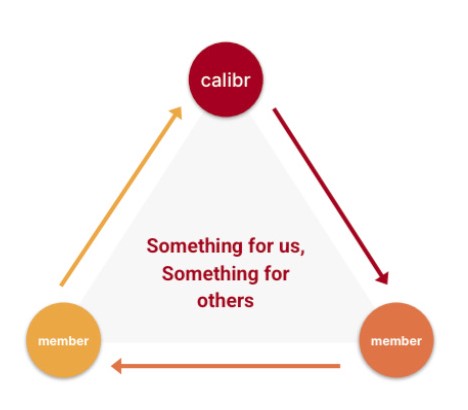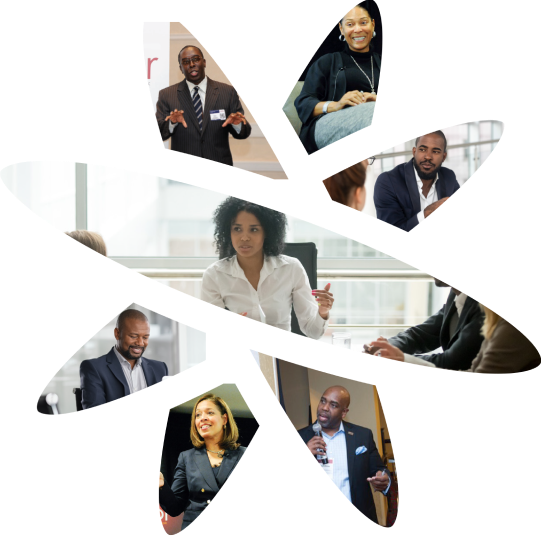For those who didn’t participate
in the 2025 Summer Conference and
Global Executive Forum
CALIBR’s 2025 Summer Leadership Development Conference and Global Executive Forum featured programming to help members, guests, and sponsors build resilience in a dynamic business and political climate. Designed for high-potential corporate leaders navigating VUCA (Volatility, Uncertainty, Complexity, and Ambiguity), the tailored content included sessions on leading through difficult times, navigating challenging leadership situations, and fostering a growth mindset. Participants received strategic networking guidance, relationship-building opportunities, and strategies for ascending to executive leadership with bold actions. Here are the key takeaways:

Leading Through Difficult Times
Key Takeaways:
- The Trust Recession. In good times and bad, trust is foundational for relationships to thrive, personally and in business. The current trust recession (driven by polarization, misinformation, and rapid change) reflects a widespread decline in confidence in institutions, leaders, and relationships. The erosion of trust disrupts productivity, culture, team belonging, and ultimately, revenue goals.
- Intentional Trust-Building. Trust must be intentional. Leaders must consciously build trust every day. While trust at home may come naturally, at work, it requires effort and is central to effective leadership.
- Resistance as a Signal. Resistance, such as slow decisions or quiet quitting, often indicates a trust deficit rather than opposition.
- Trust is Built in Moments. Trust is earned incrementally, one interaction at a time. Every exchange is a chance to make a “trust deposit”—by showing up with executive presence, authenticity, and curiosity. Prioritize meaningful dialogue, and, when time is limited, maximize even the smallest interactions to reinforce connection and credibility.
- Hierarchy and Influence. Trust flows both up and down. To build upward, identify what stakeholders value most and lead with credibility, clarity, and follow-through. To build downward, prioritize empathy, consistency, and psychological safety. Those with less formal authority earn trust through their personal brand and relationships. Build authentic relationships by engaging with others beyond transactional interactions.
- Identity and Bias. Our words and actions are filtered through lenses of race, gender, or culture. Effective leaders cultivate self-awareness and adapt their approach to navigate these dynamics with empathy and impact.
Executive Maturity: Path to Promotion
Key Takeaways:
- Why it Matters. Executive Maturity drives your ability to influence and create impact. Regardless of your function, positioning yourself as a business partner creates influence as you shift from task execution to ownership—understanding how the organization sets priorities, generates revenue, controls costs, and grows profit.
- Gaining Strategic Clarity. If priorities aren’t clear, listen to earnings calls, develop cross-functional relationships, and engage leaders directly. Ask what their challenges are and offer meaningful support—even beyond your current role.
- Advancement Tactics. Use skip-level interactions to share strategic insights and highlight achievements. These informal moments can be high-impact opportunities to demonstrate enterprise thinking and leadership readiness.
Your Leadership Reputation: Making it Work For You
Key Takeaways:
- What it is. Leadership reputation is what people say about you when you’re not in the room. It’s not just what you do—it’s how others interpret what you do over time.
- Self-Awareness Tip. The gap between how we see ourselves and how others see you is a signal, not a flaw.
- P.I.E. Strategy. Your strategic contributions (performance), strategic identity (image), and strategic visibility (exposure to the key influencers) are three important levers for controlling your leadership reputation and leveraging it as a key asset.
Achieving a Growth Mindset
Key Takeaways:
- What It Is. A growth mindset is the belief that skills can be developed through effort, strategy, and feedback. Individuals with a growth mindset: 1) embrace challenges, 2) welcome feedback as a tool for improvement, 3) view others’ success as inspiration, 4) treat failure as a learning opportunity, and 5) stay accountable and committed to improvement.
- Build Influence with Growth Language. Use growth-oriented language to build trust—especially when engaging with those with fixed mindsets who might: 1) avoid challenges, 2) react defensively to feedback, or 3) equate failure with incompetence.
- Practical Applications. 1) Frame problems clearly without prescribing solutions, 2) make feedback actionable and constructive, 3) recognize when beliefs—not just skills—need to shift, and 4) foster environments where openness and risk-taking are encouraged.
- Diagnosing Root Causes. Avoid ambiguity and gray areas when solving problems. Use tools like the “5 Whys” and the “Results Ladder/Pyramid” to promote clarity and drive solutions.
Navigating Sticky Leadership Situations
Key Takeaways:
- Leadership Reality Check. “Sticky” situations are high-risk decisions with potential legal, reputational, and organizational fallout. Leaders—especially those of color—face heightened scrutiny in post-DEI climates and may be personally named in lawsuits stemming from perceived bias.
- Legal and Risk Awareness. Good intentions don’t protect against legal missteps. Leaders must understand key laws—e.g., Civil Rights Act, Americans with Disabilities Act, Equal Pay Act—and be alert to reverse discrimination claims. A legal lens is not optional; it’s foundational.
- Strategic Mindset. Leadership is constant negotiation—with employees, peers, and the C-suite. Decision-makers must balance empathy, inclusion, and legal prudence. Presence, timing, and tone should be used as strategic assets.
- Situational Awareness. Mentorship or equity-based actions can be misread as favoritism. Identify and address overt and subtle bias before it becomes a legal or HR issue. Perceptions matter.
- Leadership Best Practices. Document everything (e.g., conversations, decisions, accommodations)—especially in gray areas. Partner strategically with HR, but know their duty is to the organization. Treat every sensitive situation as discoverable.
- Career Safeguards. Proactively cultivate relationships with legal counsel. Stay vigilant. One high-risk misstep can override years of credibility.
The Audacity Equation: A Framework for Bold Leadership Action
Key Takeaways:
- Turning Setbacks into Strategy. Marty McDonald faced two layoffs, transitioned from a corporate marketing career to entrepreneurship after being repeatedly overlooked, and self-funded her leap with a $40K withdrawal from her retirement savings. Key Quote: “Once you see the vision, you can’t unsee it.”
- Entrepreneurship in Action. Founded Boss Women Media, building brand experiences and community for 200K+ women through partnerships with major brands like Amazon, Capital One, and Cash App. From a “Black Girl Magic” gummy bear pitch to a 6-figure deal with Capital One and the launch of a toddler brand (Elle Olivia) with major retail partnerships—her ventures blend empowerment, innovation, and scale.
- Resilience Under Pressure. Battled racial bias, survived a 10X production error, and raised $350K funding through cold outreach, all while raising twins and a toddler. Marty’s story reflects audacity rooted in grit and resourcefulness.
- Key Quote: “Don’t be afraid to allow someone to help you, even if they don’t look like you. Be open to asking for what you really need. Some of us are sitting in this room, in this space right now, and we’re not asking for exactly what we need. We’re also not willing to offer anything to anybody else. You’ve got to be willing to give, and you’ve got to be willing to ask. That’s how change happens [for you] in this current climate.”
- Audacious Takeaways. Bet on yourself. Vision + Action = Transformation. Faith and networks are fuel. Adversity becomes advocacy. Rejection builds momentum.
